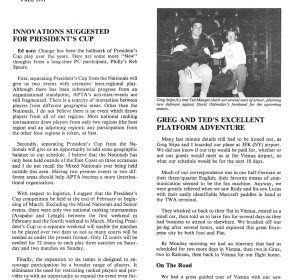Innovations suggested for President’s Cup
Change had been the hallmark of President’s Cup play over the years and Reb Speare provided some more. In PTN’s Fall 1991 issue, he announced the oranization’s decision to separate the President’s Cup from the Nationals, and offered the following reasons:
“First, separating President’s Cup from the Nationals will give us two events with extensive inter-regional play. Although there has been substantial progress from an organizational standpoint, APTA’s activities/ events are still fragmented. There is a scarcity of interaction between players from different geographic areas. Other than the Nationals, I do not believe there is an event that draws players from all of our regions. Most national ranking tournaments draw players from only two regions (the host region and an adjoining region); any participation from the other four regions is token, at best.
Secondly, separating President’s Cup from the Nationals will give us an opportunity to add some geographic balance to our schedule. I believe that the Nationals has only been held outside of the East Coast on three occasions and I do not recall the Mixed Nationals ever being held outside this area. Having two premier events in two different areas should help APTA become a more (inter) national organization. With respect to logistics, I suggest that the President’s Cup competition be held at the end of February or beginning of March. Excluding the Mixed Nationals and Senior events, there were only two national ranking tournaments (Arapaho and· Lehigh) between the first weekend in February and the fourth weekend in March. Moving President’s Cup to a separate weekend will enable the matches to be played over two days so not as many courts will be needed as under the present format. Only 12 courts will be needed for 72 teams to each play three matches on Saturday and two matches on Sunday.
Finally, the expansion to six teams is designed to encourage participation by a broader range of players. It eliminates the need for restricting ranked players and provides us with an opportunity to expand the event even further. The present format is not conducive to growth although the participation level has steadily increased (all of the regions indicated that they could have fielded six teams for last year’s President’s Cup).”
Source: Platform Tennis News, Fall 1991




